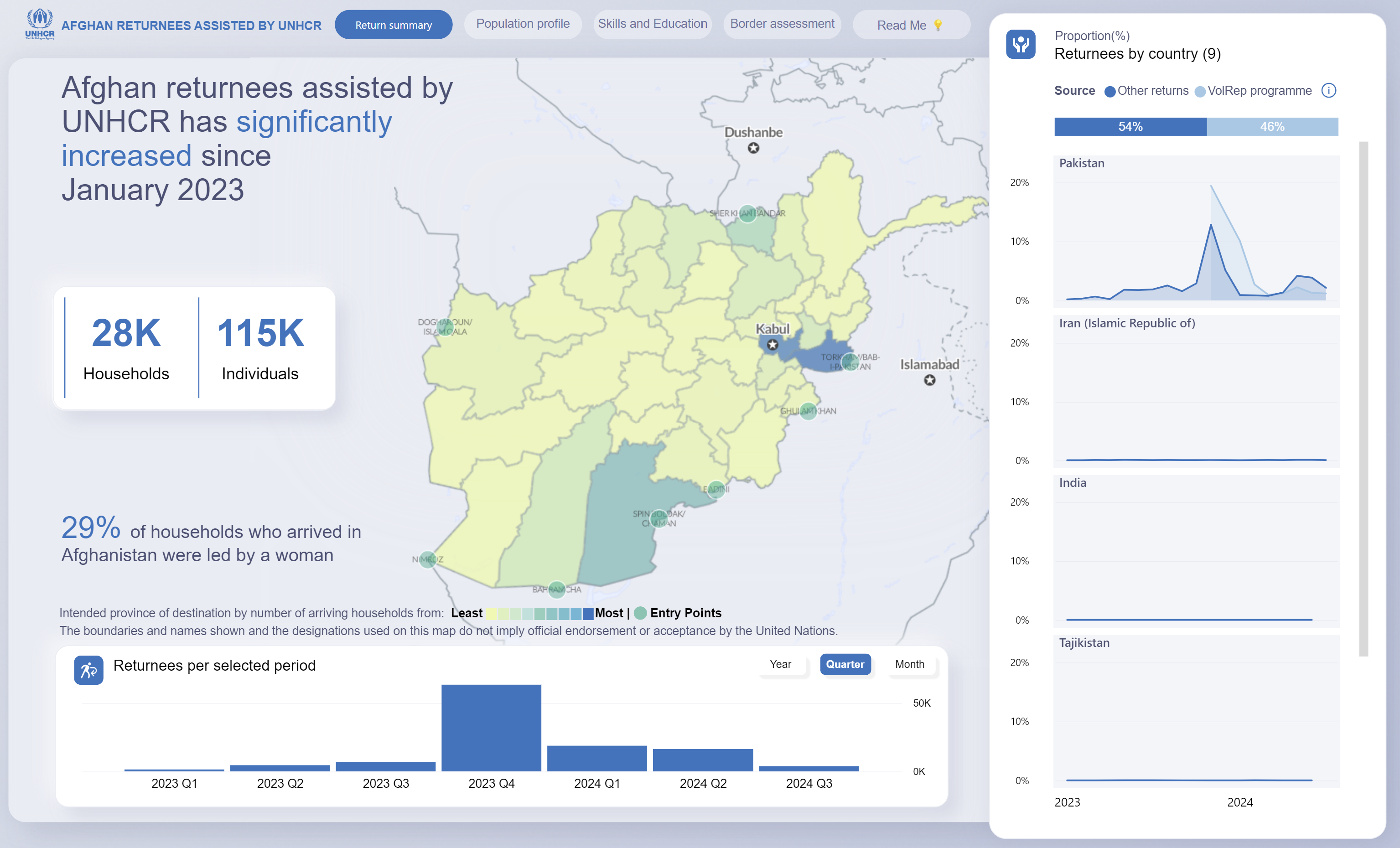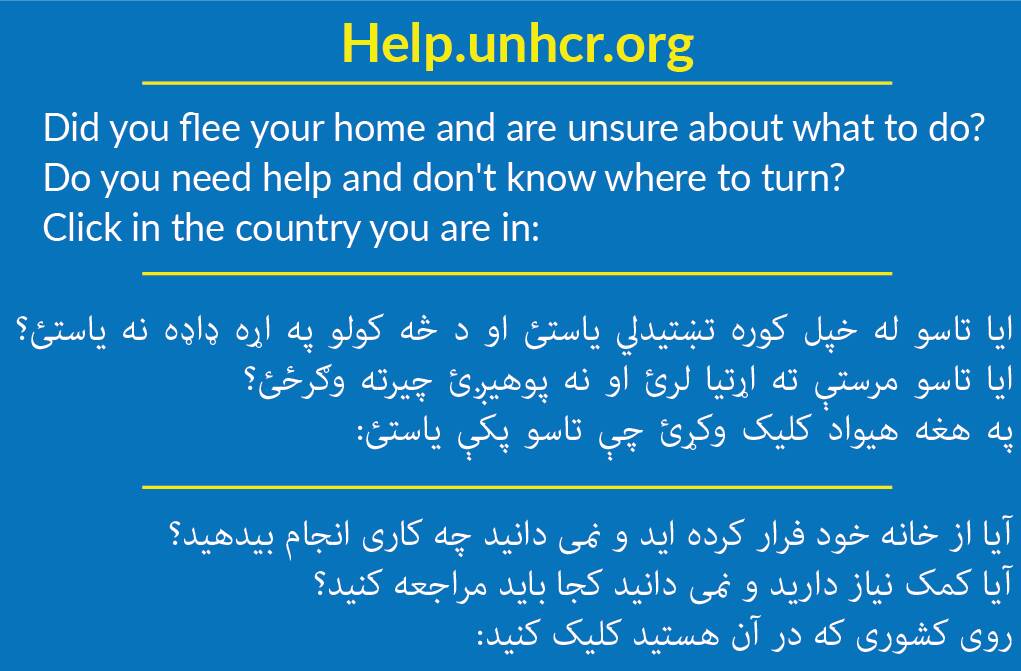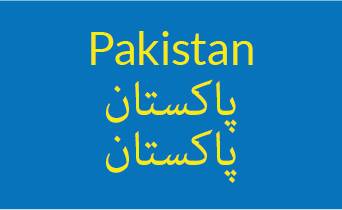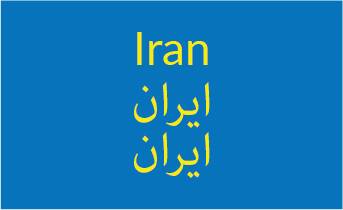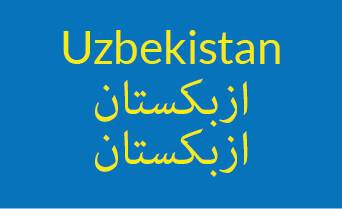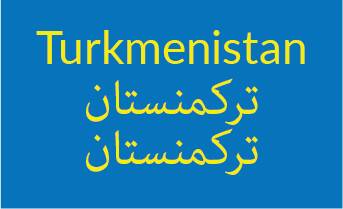JSON
* People in refugee-like situation refers to a category which is descriptive in nature and includes groups of people who are outside their country or territory of origin and who face protection risks similar to those of refugees, but for whom refugee status has, for practical or other reasons, not been ascertained. In Pakistan, people in refugee-like situations include 146,200 unregistered members of registered families who were being verified at the time of reporting and were recorded through the documentation renewal and information verification exercise (DRIVE). It also includes Afghans who arrived in the country since the Taliban takeover in August 2021 reflecting new population estimates reported by the Government of Pakistan. People in refugee-like situations in the Islamic Republic of Iran include 2.6 million Afghans who were recorded in a Government-conducted exercise. In 2022, the Government of the Islamic Republic of Iran conducted a recount of the previously "head counted" population, and extended the scope of this scheme to all undocumented Afghans residing in Iran, including those who had newly arrived due to the Taliban takeover in 2021 in Afghanistan. It is reported that 2.6 million Afghans enrolled in this exercise which provides them with a headcount slip and temporary protection from deportation. The refugee-like category also includes 91,950 Afghan individuals who arrived to Iran post August 2021 and approached UNHCR receptions, indicating not to be in possession of an Amayesh card or 2022 Headcount Slip. For Uzbekistan, people in refugee-like situations include Afghan nationals residing temporarily in Uzbekistan. This is according to publicly accessible information, as there are no official data provided by the Government of Uzbekistan.
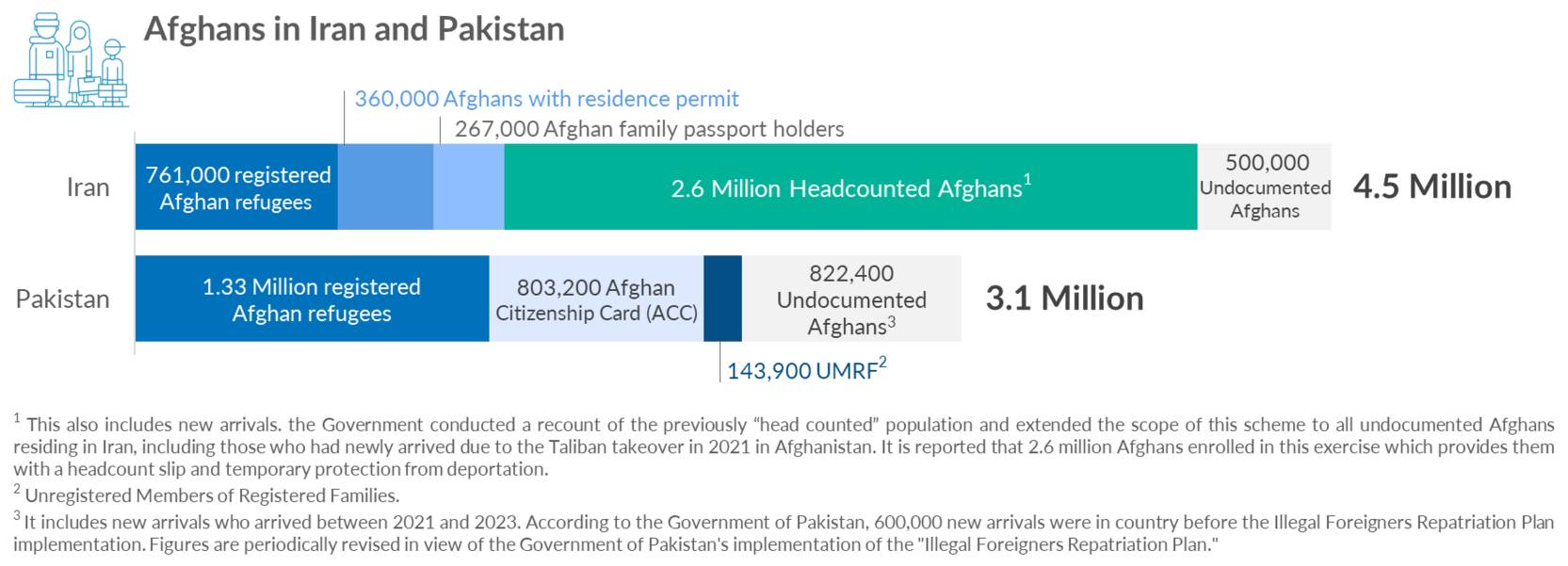
On 3 October 2023, Pakistan’s national Apex Committee endorsed a plan to repatriate over a million foreigners without valid documents, largely Afghans. Announcing the plan, Pakistan’s Minister of Interior said that an ultimatum has been issued to illegal foreigners residing in Pakistan, requiring them to leave the country by 1 November 2023. The overall situation inside Afghanistan deteriorated in 2021 and has had significant consequences for the most vulnerable among the population. Some 3.25 million people are currently internally displaced by conflict, over 1 million IDPs have returned to their places of origin, and at least 1.6 million new arrivals have been witnessed in neighbouring countries. UNHCR is responding to this emergency, with needs outlined in a regional Refugee Response Plan (RRP) and Afghanistan’s Humanitarian Response Plan (HRP). Iran and Pakistan, which are neighbours of Afghanistan, also host some 5.5 million Afghan refugees and Afghans in a refugee-like situation. The majority of refugees fled Afghanistan over the years, including from as early as 1979. While 6.2 million refugees returned to Afghanistan in phases since 2002, this trend has been declining in recent times with just over 6,500 people choosing to return in 2022. Since August 2021, UNHCR has maintained a non-return advisory for Afghanistan (reaffirmed in February 2023 in the Guidance Note on International Protection Needs of People Fleeing Afghanistan; Update 1), calling for a halt on forced returns of Afghan nationals. On this page you will find updates on UNHCR's work in support Afghan IDPs, refugees and returnees. Links are also provided below for the individual UNHCR country operation pages for additional information.
| Location name | Source | Data date | Population | |
|---|---|---|---|---|
| Iran (Islamic Republic of) | Various | 30 Jun 2024 | 67.9% | 3,752,300 |
| Pakistan (Islamic Republic of) | Various | 30 Jun 2024 | 31.7% | 1,751,500 |
| Tajikistan | Various | 30 Jun 2024 | 0.2% | 10,400 |
| Turkmenistan | Various | 30 Jun 2024 | 0.1% | 3,500 |
| Uzbekistan | Various | 30 Jun 2024 | 0.2% | 9,000 |
| Location name | Source | Data date | Population | |
|---|---|---|---|---|
| Iran (Islamic Republic of) | Government | 31 Jul 2022 | 62.5% | 1,000,000 |
| Pakistan (Islamic Republic of) | Government | 31 Jan 2023 | 37.5% | 600,000 |
In Iran, UNHCR is using an average figure according to various government estimates and continues to follow-up with authorities to receive updated and disaggregated data as well as an estimate of how many presently remain in Iran. Of the average 1 million new arrivals, over 88,000 Afghans have approached UNHCR. Of the 600,000 new arrivals reported by the Government of Pakistan, over 476,000 have approached UNHCR.
Total returns is an umbrella term that includes all returns including deportations, assisted Voluntary Repatriation (VolRep) and other returns of Afghans of all statuses such as PoR cardholders, ACC holders, and the undocumented.
Including Facilitated Volrep, Proof of Registration card holders, UNHCR slip holders, their nuclear family members with or without documentation, UNHCR asylum certificate holders and protection referrals.
- Todos los documentos (843)
- 3W (4)
- Actualizaciones (27)
- Actualizaciones de situaciones (19)
- CORE (9)
- COVID-19 (9)
- Comunicados de Prensa (2)
- Datos y estadísticas (22)
- Documentos 3RP (2)
- Documentos RRP Regionales (3)
- Documentos de estrategia (18)
- Evaluaciones (10)
- Financiamiento (2)
- Flash Update (4)
- Informes (36)
- Informes / Actualizaciones de Situación (143)
- Informes de Situación (2)
- Informes y documentos sobre políticas (1)
- Informes y evaluaciones (29)
- Mapas y datos geográficos (17)
- National Refugee Response Plans (7)
- Panel de indicadores y hojas informativas (565)
- Planes de Respuesta regional (12)
- Protection Brief (1)
- Sin categoría (5)
- Todos los documentos (843)
- 3W (4)
- Actualizaciones (27)
- Actualizaciones de situaciones (19)
- CORE (9)
- COVID-19 (9)
- Comunicados de Prensa (2)
- Datos y estadísticas (22)
- Documentos 3RP (2)
- Documentos RRP Regionales (3)
- Documentos de estrategia (18)
- Evaluaciones (10)
- Financiamiento (2)
- Flash Update (4)
- Informes (36)
- Informes / Actualizaciones de Situación (143)
- Informes de Situación (2)
- Informes y documentos sobre políticas (1)
- Informes y evaluaciones (29)
- Mapas y datos geográficos (17)
- National Refugee Response Plans (7)
- Panel de indicadores y hojas informativas (565)
- Planes de Respuesta regional (12)
- Protection Brief (1)
- Sin categoría (5)
Afghanistan Monthly Protection Update - September 2024
DocumentCreate date: 27 October 2024 (9 months ago)
Afghan Returns | Weekly Update 20 October – 26 October 2024
DocumentCreate date: 27 October 2024 (9 months ago)
One Year Recap: UNHCR-IOM Pakistan Flash Updates
DocumentCreate date: 23 October 2024 (10 months ago)
Afghan Returns | Weekly Update 13 October – 19 October 2024
DocumentCreate date: 21 October 2024 (10 months ago)
Afghan Returns - South West Asia Quarterly Update, 2024 Q3
DocumentCreate date: 21 October 2024 (10 months ago)
Pakistan - Afghanistan Situation Refugee Response (3Ws) as of Dec, 2022
DocumentCreate date: 4 April 2023 (2 years ago)
Pakistan - Afghanistan Situation Refugee Response (3Ws) as of June 30, 2022
DocumentCreate date: 9 December 2022 (2 years ago)
Pakistan - Afghanistan Situation Refugee Response (3Ws) as of September 30, 2022
DocumentCreate date: 9 December 2022 (2 years ago)
Pakistan - Afghanistan Situation Refugee Response (3Ws) as of March 31, 2022
DocumentCreate date: 15 June 2022 (3 years ago)
Afghanistan: Operational Update - September 2024
DocumentCreate date: 20 October 2024 (10 months ago)
Afghanistan: Operational Update - August 2024
DocumentCreate date: 18 September 2024 (11 months ago)
UNHCR Afghanistan Delivery Summary September 2024
DocumentCreate date: 9 October 2024 (10 months ago)
UNHCR Afghanistan Delivery Summary August 2024
DocumentCreate date: 9 September 2024 (11 months ago)
Afghanistan: Operational Update - July 2024
DocumentCreate date: 22 August 2024 (1 year ago)
Afghanistan: Operational Update - September 2024
DocumentCreate date: 20 October 2024 (10 months ago)
Afghanistan: Operational Update - August 2024
DocumentCreate date: 18 September 2024 (11 months ago)
Afghanistan: Operational Update - July 2024
DocumentCreate date: 22 August 2024 (1 year ago)
Afghanistan: Operational Update - June 2024
DocumentCreate date: 23 July 2024 (1 year ago)
UNHCR - Afghanistan Floods Update 1 July 2024
DocumentCreate date: 2 July 2024 (1 year ago)
Pakistan-Afghanistan - Returns Emergency Response #9
DocumentCreate date: 19 January 2024 (1 year ago)
Pakistan-Afghanistan - Returns Emergency Response #8
DocumentCreate date: 5 January 2024 (1 year ago)
Pakistan-Afghanistan - Returns Emergency Response #7
DocumentCreate date: 22 December 2023 (1 year ago)
Pakistan-Afghanistan - Returns Emergency Response #6
DocumentCreate date: 15 December 2023 (1 year ago)
Pakistan-Afghanistan - Returns Emergency Response #5
DocumentCreate date: 8 December 2023 (1 year ago)
UNHCR Iran: COVID-19 Response in the Islamic Republic of Iran - December 2021
DocumentCreate date: 14 April 2022 (3 years ago)
UNHCR Iran: COVID-19 Response in the Islamic Republic of Iran - September 2021
DocumentCreate date: 9 November 2021 (3 years ago)
UNHCR Iran: COVID-19 Response in the Islamic Republic of Iran - June 2021
DocumentCreate date: 2 September 2021 (3 years ago)
UNHCR Iran: COVID-19 Response in the Islamic Republic of Iran - April 2021
DocumentCreate date: 5 July 2021 (4 years ago)
UNHCR Iran: COVID-19 Response in the Islamic Republic of Iran - February 2021
DocumentCreate date: 16 May 2021 (4 years ago)
UNHCR Press Release: Afghanistan and UNHCR Mark World Refugee Day 20 June
DocumentCreate date: 20 June 2021 (4 years ago)
UNHCR Press Release: UNHCR calls for continued engagement and increased support for Afghanistan
DocumentCreate date: 27 May 2021 (4 years ago)
UNHCR Afghanistan Delivery Summary September 2024
DocumentCreate date: 9 October 2024 (10 months ago)
UNHCR Afghanistan Delivery Summary August 2024
DocumentCreate date: 9 September 2024 (11 months ago)
One Year Recap: UNHCR-IOM Pakistan Flash Updates
DocumentCreate date: 23 October 2024 (10 months ago)
UNHCR-IOM Pakistan Flash update # 30 on Arrest and Detention/Flow Monitoring, 15 Sep 2023 to 5 Oct 2024
DocumentCreate date: 11 October 2024 (10 months ago)
UNHCR-IOM Pakistan Flash update # 29 on Arrest and Detention/Flow Monitoring, 15 Sep 2023 to 21 Sep 2024
DocumentCreate date: 27 September 2024 (10 months ago)
Education Away from Home - The Islamic Republic of Iran (Education Brief - November 2023)
DocumentCreate date: 1 December 2023 (1 year ago)
Afghanistan Situation Regional Refugee Response Plan - 2024 Mid-year report
DocumentCreate date: 17 October 2024 (10 months ago)
Regional Refugee Response Plan 2024-2025 - Afghanistan Situation
DocumentCreate date: 11 March 2024 (1 year ago)
Regional Refugee Response Plan for Afghanistan Situation Summary 2024
DocumentCreate date: 19 January 2024 (1 year ago)
Afghanistan Regional Refugee Response Plan Summary 2023
DocumentCreate date: 10 March 2023 (2 years ago)
Protection and Solutions Strategy UNHCR Afghanistan 2025 - 2027
DocumentCreate date: 17 October 2024 (10 months ago)
UNHCR Iran: The Support Platform for the Solutions Strategy for Afghan Refugees
DocumentCreate date: 25 February 2021 (4 years ago)
SSAR Support Platform document - A Partnership for Solidarity and Resilience
DocumentCreate date: 24 June 2020 (5 years ago)
SSAR Support Platform – Concept Note
DocumentCreate date: 21 April 2020 (5 years ago)
SSAR Support Platform – Modalities
DocumentCreate date: 21 April 2020 (5 years ago)
Barriers to accessing COVID-19 related healthcare for Afghan refugees in Khyber Pakhtunkhwa, Pakistan
DocumentCreate date: 22 June 2022 (3 years ago)
IBV - Initial Assessment of the Current Situation of Afghan Refugees in Turkey; International Blue Crescent Relief and Development Foundatio...
DocumentCreate date: 9 September 2022 (2 years ago)
Priority Areas of Return and Reintegration – March 2020
DocumentCreate date: 5 May 2020 (5 years ago)
Pakistan - Participatory Assessment Findings and Recommendations, Yearly (2019)
DocumentCreate date: 4 February 2020 (5 years ago)
15 Priority Areas of Return and Reintegration (PARRs) 30 September 2019
DocumentCreate date: 17 October 2019 (5 years ago)
ReSolve: for Resilience and Solutions 2023
DocumentCreate date: 15 August 2023 (2 years ago)
Afghanistan Situation Funding Update
DocumentCreate date: 15 April 2020 (5 years ago)
Role of UNHCR in the Durable Solutions Working Group August 2024
DocumentCreate date: 1 September 2024 (11 months ago)
UNHCR Afghanistan: Flash Floods Update_ July 18 2024
DocumentCreate date: 18 July 2024 (1 year ago)
Afghanistan Floods Weekly Update :16 July 2024
DocumentCreate date: 17 July 2024 (1 year ago)
Afghanistan Floods Weekly Update :3 June 2024
DocumentCreate date: 4 June 2024 (1 year ago)
UNHCR Afghanistan Complaints and Feedback Mechanism Monthly Report - August 2024
DocumentCreate date: 15 October 2024 (10 months ago)
Afghanistan Monthly Protection Monitoring Summary August 2024
DocumentCreate date: 17 September 2024 (11 months ago)
Priority Areas of Return and Reintegration (PARRs) - Chinese version
DocumentCreate date: 4 September 2024 (11 months ago)
Role of UNHCR in the Durable Solutions Working Group August 2024
DocumentCreate date: 1 September 2024 (11 months ago)
Afghanistan Protection Brief - August 2024
DocumentCreate date: 1 September 2024 (11 months ago)
Afghanistan: Operational Update - September 2024
DocumentCreate date: 20 October 2024 (10 months ago)
Pakistan-Afghanistan - Returns Emergency Response #23
DocumentCreate date: 1 October 2024 (10 months ago)
UNHCR Afghanistan Situation Update - 1 September 2024
DocumentCreate date: 19 September 2024 (11 months ago)
Afghanistan: Operational Update - August 2024
DocumentCreate date: 18 September 2024 (11 months ago)
Pakistan-Afghanistan - Returns Emergency Response #22
DocumentCreate date: 17 September 2024 (11 months ago)
UNHCR AFGHANISTAN EARTHQUAKE RESPONSE EXTERNAL UPDATE#1
DocumentCreate date: 6 July 2022 (3 years ago)
UNHCR Earthquake Emergency Response External Update#2
DocumentCreate date: 6 July 2022 (3 years ago)
Legal Identity and Civil Documentation in Afghanistan
DocumentCreate date: 11 June 2024 (1 year ago)
Education Away from Home - The Islamic Republic of Iran (Education Brief - November 2023)
DocumentCreate date: 1 December 2023 (1 year ago)
Asia and the Pacific Regional Trends - Forced Displacement and Statelessness 2022
DocumentCreate date: 4 July 2023 (2 years ago)
UNHCR 2022 Multi Sectorial Rapid Assessments - Analysis
DocumentCreate date: 17 May 2023 (2 years ago)
UNHCR RBAP 2022 Cash-Based Interventions in the Region
DocumentCreate date: 19 April 2023 (2 years ago)
UNHCR Brazil - Protection and assistance of Afghans in Brazil [PT]
DocumentCreate date: 12 September 2022 (2 years ago)
UNHCR Representation to Kazakhstan, Kyrgyz Republic, Turkmenistan and Uzbekistan - subregional map
DocumentCreate date: 1 August 2023 (2 years ago)
Afghanistan: UNHCR Area of Responsibility Map 2022
DocumentCreate date: 1 February 2022 (3 years ago)
Afghanistan: ESNFI Cluster Coordination Structure as of 15 December 2021
DocumentCreate date: 23 December 2021 (3 years ago)
Afghanistan: ESNFI Cluster Members, December 2021
DocumentCreate date: 23 December 2021 (3 years ago)
Afghanistan: ES-NFIs Cluster Operational Presence Dashboard November 2020
DocumentCreate date: 17 December 2020 (4 years ago)
UNHCR - Pakistan Cash Based Interventions (CBI) Dashboard as of May 2, 2023
DocumentCreate date: 3 May 2023 (2 years ago)
UNHCR - Pakistan Cash Based Interventions (CBI) Dashboard as of June 15, 2023
DocumentCreate date: 16 June 2023 (2 years ago)
UNHCR - Pakistan Cash Based Interventions (CBI) Dashboard as of April 13, 2023
DocumentCreate date: 13 April 2023 (2 years ago)
UNHCR - Pakistan Cash Based Interventions (CBI) Dashboard as of March 31, 2023
DocumentCreate date: 31 March 2023 (2 years ago)
UNHCR - Pakistan Cash Based Interventions (CBI) Dashboard as of March 20, 2023
DocumentCreate date: 20 March 2023 (2 years ago)
Afghanistan Monthly Protection Update - September 2024
DocumentCreate date: 27 October 2024 (9 months ago)
Afghan Returns | Weekly Update 20 October – 26 October 2024
DocumentCreate date: 27 October 2024 (9 months ago)
Afghan Returns | Weekly Update 13 October – 19 October 2024
DocumentCreate date: 21 October 2024 (10 months ago)
Afghan Returns - South West Asia Quarterly Update, 2024 Q3
DocumentCreate date: 21 October 2024 (10 months ago)
UNHCR Afghanistan Livelihoods Factsheet - August 2024
DocumentCreate date: 17 October 2024 (10 months ago)
Afghanistan Situation Regional RRP 2023 Final Report
DocumentCreate date: 26 June 2024 (1 year ago)
Regional Refugee Response Plan 2024-2025 - Afghanistan Situation
DocumentCreate date: 11 March 2024 (1 year ago)
Regional Refugee Response Plan for Afghanistan Situation Summary 2024
DocumentCreate date: 19 January 2024 (1 year ago)
Afghanistan Situation RRP - Mid-year Report 2023
DocumentCreate date: 27 October 2023 (1 year ago)
Regional Refugee Response Plan 2022 - Final Report
DocumentCreate date: 8 May 2023 (2 years ago)
Afghanistan Protection Brief - August 2024
DocumentCreate date: 1 September 2024 (11 months ago)
UNHCR - Pakistan Overview of Refugee and Asylum-Seekers Population as of June 30, 2023
DocumentCreate date: 12 July 2023 (2 years ago)
UNHCR - Pakistan Voluntary Repatriation of Afghan Refugees as of June 30, 2023
DocumentCreate date: 12 July 2023 (2 years ago)
UNHCR - Pakistan Voluntary Repatriation of Afghan Refugees as of August 31, 2023
DocumentCreate date: 12 September 2023 (1 year ago)
UNHCR - Pakistan Overview of Refugee and Asylum-Seekers Population as of March 31, 2023
DocumentCreate date: 21 April 2023 (2 years ago)
UNHCR - Pakistan Voluntary Repatriation of Afghan Refugees as of March 31, 2023
DocumentCreate date: 21 April 2023 (2 years ago)
| Date of Funding Data | 30 September 2024 (10 months ago) |
-
Regional Refugee Response Plan 2024-2025 - Afghanistan Situation
Regional Refugee Response Plan 2024-2025 - Afghanistan SituationPublish date: 11 March 2024
-
Afghanistan Situation Regional Refugee Response Plan - 2024 Mid-year report
Publish date: 17 October 2024
-
UNHCR-IOM Pakistan Flash update # 30 on Arrest and Detention/Flow Monitoring, 15 Sep 2023 to 5 Oct 2024
Arrest and Detention/Flow Monitoring, 15 Sep 2023 to 5 Oct 2024Publish date: 11 October 2024
-
ReSolve: for Resilience and Solutions 2023
2023 Multi-Stakeholder Pledge for the Afghanistan SituationPublish date: 14 August 2023
-
Afghanistan Crisis update: Women and Girls in Displacement | Factsheet III - May 2023
Publish date: 24 May 2023
Micro Data | Afghanistan Situation - latest 5
Rapid Household Assessments 2024 January-June
Afghanistan, 2024 MicroData View details | Get MicrodataAuthoring Entity: UNHCR
Published: 06 December 2024
Community Based Protection Monitoring 2024 January-June
Afghanistan, 2024 MicroData View details | Get MicrodataAuthoring Entity: UNHCR
Published: 06 December 2024
Community Based Protection Monitoring 2024 July - September
Afghanistan, 2024 MicroData View details | Get MicrodataAuthoring Entity: UNHCR
Published: 18 March 2025
Community Based Protection Monitoring 2024 October - December
Afghanistan, 2024 MicroData View details | Get MicrodataAuthoring Entity: UNHCR
Published: 18 March 2025
Rapid Household Assessments 2024 July - September
Afghanistan, 2024 MicroData View details | Get MicrodataAuthoring Entity: UNHCR
Published: 18 March 2025





















































































